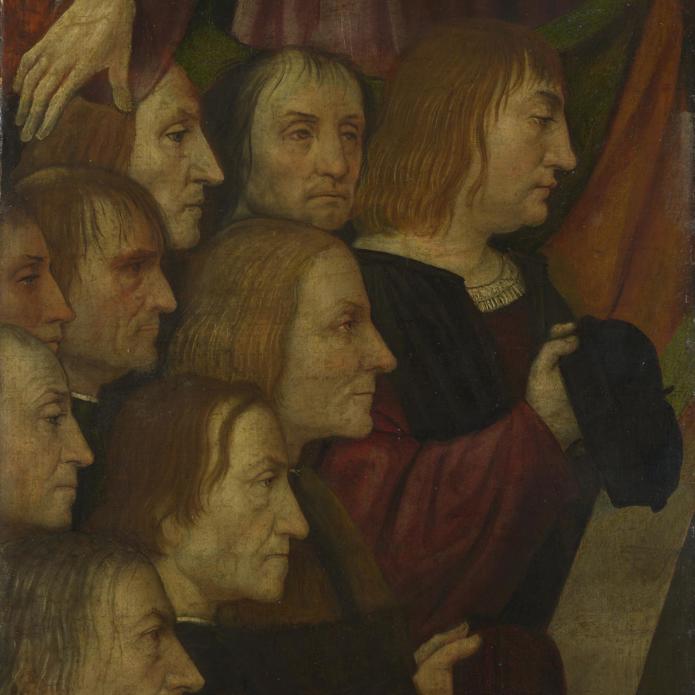Italian, Milanese, 'Male Members of a Confraternity', about 1500
About the work
Overview
Nine men kneel in prayer, heads bare, hats in hands. Behind them stands a saint – we can only see his hand – wearing a brown garment (perhaps the habit worn by members of a religious order). It is possibly Saint Francis, who founded the Franciscan Order, presenting the men to the object of their devotion.
These are the male members of a confraternity (a quasi-religious brotherhood) and the painting once formed part of the banner which the confraternity carried in processions. Another fragment, also in the National Gallery’s collection, shows the female members.
We don't know who the artist was, but the style of dress worn in both fragments was fashionable in about 1500. They were perhaps members of the confraternity of the Immaculate Conception, founded in Milan in 1475 under the oversight of the Franciscans.
Key facts
Details
- Full title
- Male Members of a Confraternity
- Artist
- Italian, Milanese
- Part of the series
- Fragments of a Confraternity Banner
- Date made
- about 1500
- Medium and support
- oil on canvas, mounted on wood
- Dimensions
- 64.5 × 41.9 cm
- Acquisition credit
- Bought, 1867
- Inventory number
- NG779
- Location
- Not on display
- Collection
- Main Collection
Provenance
Additional information
Text extracted from the ‘Provenance’ section of the catalogue entry in Martin Davies, ‘National Gallery Catalogues: The Earlier Italian Schools’, London 1986; for further information, see the full catalogue entry.
Bibliography
-
1868R.N. Wornum, Descriptive and Historical Catalogue of the Pictures in the National Gallery, London 1868
-
1871J.A. Crowe and G.B. Cavalcaselle, A History of Painting in North Italy: Venice, Padua, Vicenza, Verona, Ferrara, Milan, Friuli, Brescia, from the Fourteenth to the Sixteenth Century, 2 vols, London 1871
-
1895L. Beltrami, Ambrogio da Fossano detto il Borgognone, Milan 1895
-
1898H.F. Cook, Catalogue of Pictures by Masters of the Milanese and Allied Schools of Lombardy, London 1898
-
1899Giulio Carotti', Le Gallerie Nazionali Italiane: notizie e documenti, 1899
-
1904H.F. Cook, 'Some Notes on the Early Milanese Painters Butinone and Zenale. Part III (conclusion). Zenale as a Portrait Painter', The Burlington Magazine, V/14, 1904, pp. 199-200
-
1911National Gallery, An Abridged Catalogue of the Pictures in the National Gallery, London 1911
-
1913National Gallery, Descriptive and Historical Catalogue of the British and Foreign Pictures, 81st edn, London 1913
-
1921National Gallery, National Gallery, Trafalgar Square: Catalogue of the Pictures, London 1921
-
1951Davies, Martin, National Gallery Catalogues: The Earlier Italian Schools, London 1951
-
1986Davies, Martin, National Gallery Catalogues: The Earlier Italian Schools, revised edn, London 1986
-
1991J. Dunkerton et al., Giotto to Dürer: Early Renaissance Painting in the National Gallery, New Haven 1991
-
2001
C. Baker and T. Henry, The National Gallery: Complete Illustrated Catalogue, London 2001
About this record
If you know more about this painting or have spotted an error, please contact us. Please note that exhibition histories are listed from 2009 onwards. Bibliographies may not be complete; more comprehensive information is available in the National Gallery Library.
Images
About the series: Fragments of a Confraternity Banner

Overview
Medieval and Renaissance painters worked on a wide variety of objects, not just pictures intended to be hung on walls. Here we have a rare survival of an important type of artwork from this time: a painted banner.
Banners like this were designed to be seen from a distance. They were usually around 2.5 metres high, and hung from a tall wooden cross which would be carried at the head of public processions.
Made in Milan in around 1500, the banner from which these came was possibly associated with the important confraternity of the Immaculate Conception (the belief that the Virgin Mary was conceived without sin). This was set up in Milan under the sponsorship of the Franciscan Order. Behind the group of kneeling men we can see part of a figure of a saint, apparently dressed in brown robes – perhaps Saint Francis.




